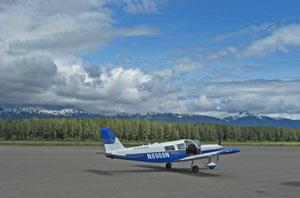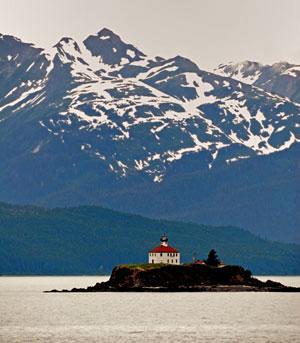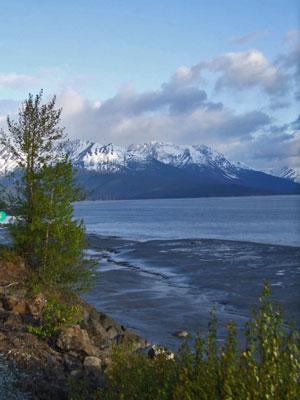The enormous variety of areas in the National Park System means there's also quite a range of experiences when it comes to getting to and from your park destination. Whether you're taking the subway or city bus to an urban park or riding a train, small plane or ferry to reach your destination in Alaska, there are plenty of options for a memorable trip...and sometimes they can be memorable indeed.
Alaska certainly offers some of the best opportunities for interesting access to parks, and Glacier Bay National Park and Preserve provides a good example. During the summer you can reach the park via standard jet service on a very short hop from Juneau to Gustavus, Alaska, but a much more interesting option is a small plane ride over that same route.
Now some of you may ask, just how small a plane are we talking about? They vary a bit, but don't be surprised if total capacity is eight people or less. For the uninitiated, your first clue about one of these flights comes at the ticket counter, where they'll carefully weigh your suitcase and then politely ask you to step on the scale. For single-engine aircraft, both size and weight matter when it comes to passengers and their luggage.

A flight by small plane is one way to get to Glacier Bay National Park. Jim Burnett photo.
My wife and I opted for one of these trips a few years ago, and our outbound flight was on an eight-seater. This was my bride's first experience with small plane travel, so she shot me one of those raised-eyebrow looks when we strolled out of the terminal onto the tarmac and she got her first glimpse of our ride.
The pilot loaded the cargo himself, and then helped us aboard. No worry about boarding passes; seat selection was cheerfully sorted out among us and one other passenger. Our return flight, several days later, was a four-seater, and we got a much closer look at the scenery that we would have on the big jet for Alaska Airlines, and that's the chief advantage of these trips.
Yes, it was a little bumpy at times on a windy day, but if you're not averse to a short hop on a small plane, these aircraft let you combine the advantages of a "flight-seeing" experience with a convenient way to reach the park.

The Alaska Marine Highway offers a scenic and leisurely way to travel to places like Skagway. Jim Burnett photo.
For those averse to air travel of any kind, the Alaska Marine Highway (a.k.a. the Alaskan ferry system) has added service between Juneau and Gustavus (the "gateway" community for Glacier Bay). Ferries run this route, which takes about four hours, about two or three times a week - so plan ahead.
The Alaska Marine Highway also offers a great way to enjoy a leisurely trip to several other parks, including Sitka National Historical Park and Klondike Gold Rush National Historical Park at Skagway. We enjoyed this trip by ferry from Juneau to Sitka; our vessel offered very comfortable seating, good food at reasonable prices, and sweeping views of the southeastern Alaska scenery. Depending upon which ship is making a specific run, this ride can take anywhere from less than five hours to most of a day, so check the timetable carefully before booking.
A popular way for many people to sample Alaska is an Inside Passage cruise, and depending upon the specific itinerary, those trips may offer either a peek at Glacier Bay or a day's layover at places like Sitka or Skagway. Many of those cruises begin or end at Seward, with connections to the airport at Anchorage via "motor coach."
That bus trip is reputed to be a scenic drive, but if you're passing through Seward as part of your cruise, it would be a real shame to miss an alternative way to get between Anchorage and Seward: the Alaska Railroad.
If you enjoy the combination of jaw-dropping views of mountain scenery and comfortable travel, the train dubbed the Coastal Classic offers both in abundance. Service is offered between Seward and Anchorage from mid-May through mid-September, and a one-way trip takes a little over four hours.

The train from Seward to Anchorage offers some fine views of both the coast and mountains. Jim Burnett photo.
Seward is the gateway to Kenai Fjords National Park, and an early morning departure from Anchorage allows you to spend about seven hours in Seward, then take the return trip back to Anchorage the same day, although that would be a shame. You need to get out of Seward and onto a boat tour to really enjoy this park, and this is a park that deserves more than just a few hours.
The Alaska Railroad also offers an alternative way to reach Denali National Park via the Denali Star from either Anchorage or Fairbanks, and those trains offer not only fine views of the landscape, they free everyone in your group from the risk of missing the scenery while handling the driving.
You don't, of course, have to venture all the way to Alaska for some interesting travel experiences to parks. Amtrak offers service to or near a number of park destinations, including Glacier National Park, and private rail service to the South Rim of the Grand Canyon provides another unique rail trip.
Even mainstream destinations like the Grand Canyon may also offer the opportunity for small plane travel adventures, and a personal experience on one such flight years ago provides a reminder that such travel isn't for everyone.
Back in the early 1970s, I was working at the Grand Canyon, and had to make an urgent trip "back east." The fastest option at that time began with a small, scheduled airline that offered service from the airport at Tusayan, just outside the South Entrance to the park, to Las Vegas, where I could make a connection to the rest of the world.
I don't recall if this was a single or twin-engine plane, but it carried only about eight passengers, and the flight was full enough that the pilot asked which one of us wanted to sit the in front seat next to him. Sounded like fun to me, so I strapped in, and we headed west.
Within thirty minutes we were dodging lightning bolts in a classic desert thunderstorm, and the pilot calmly announced that since the storm tops were too high for him to climb over, we'd just stay under the worst of the storm.
The ride got pretty bumpy and a glimpse out the window revealed that "staying under the storm" offered a little closer view of the scenery'and the tree tops'than I would have preferred. Even over the noise of the plane's engines, I began to notice a very distinct clicking sound, and based on my limited experience, it didn't appear to be a normal noise for a aircraft.
A bit concerned, I turned to look over my shoulder to see if I could identify the source. An older woman sitting in the row behind me had her eyes tightly closed, but her hands were working at warp speed ... with a set of rosary beads!
We completed our flight safely, and I'm happy to report that none of my other experiences with small planes, ferries or trains have been in this category of travel "on a wing and a prayer." Getting to a park via something other than your own four wheels can offer an interesting alternative to travel, so depending upon your budget, schedule and comfort level, you might give some of these options a try.




Comments
That's appalling!
I'm hoping to finally be able to book a trip this summer on the ferries from Bremerton to Haines with stops along the way.
Eliminating them would be a first class tragedy.
But money is SO much more important. . . .
Lee
That might be from Bellingham to Haines or Skagway. I'm not certain about a Bremerton ferry. The University of Wikipedia says that AML goes as far south as Bellingham, which is where we got on when we moved up here.
Lee - hope you get to make that trip! I've not done an overnight on the ferries; a peek at one of the cabins indicated they are pretty basic, but there's loads of good seating and moving around space in the public areas, and quite a few people just "camp out" on the deck.
I won't try to plan your trip for you, and don't what you've already seen of Alaska. That said, based on my limited experience of just 3 trips "up there," if you can include a layover in Juneau, a day trip by boat to Tracy Arm, south of Juneau, is well worth considering. That fjord rivals Glacier Bay for incredible scenery, and Misty Fjords National Monument (another day trip by boat out of Ketchikan) is also outstanding. Might as well figure out a way to just spend the summer in Alaska and be done with it :-)
Visiting the national park units in southwestern Alaska (Lake Clark National Park, Katmai National Park, Anianchak National Monument, and Alagnak Wild River) requires a small plane. No roads connect to the outside world and the closest ferry terminal is on Kodiak Island, so you have to fly in. Fortunately there are hundreds of commerical operators who fly out to these amazing parks. It's a wonderful way to see some of the most beautiful landscape scenery in North America, but keep in mind that fog, clouds, and winds ocassionally ground small planes well into the afternoon, and may even prevent air operations for the day. It pays to be flexible and have a backup plan if your first day is weathered out.
Jim, I'll accept any tips gratefully.
I plan to camp out on deck.
My only experience on (but not in) Alaska was a time I flew up with an Apache fire crew to a fire burning northeast of Fairbanks. The pilot circled the fire, which as near as we could tell was threatening nothing. We could actually see WATER under the flames. Permafrost was thawing, I guess. The pilot then advised us that we were being diverted back to a fire in Montana and said we'd stop for fuel and then be gone. He then said, "And for God's sake, don't anyone open the door!"
The explanation for that came as soon as we had stopped at the fuel dock and hordes of MOSQUITOES literally covered the windows almost instantly. Outside we could see clouds of them circling like bloodthirsty little vultures. The fueling crew were all wearing wide brimmed hats holding nets and had long sleeves and pantlegs tightly tied around wrists and ankles.
We gave profound thanks for our good luck and felt very lucky to face only a few thousand Montana mosquitos.
I'm banking on the hope that mosquitos don't like salt water -- and if they do, that whales love to eat mosquitos.